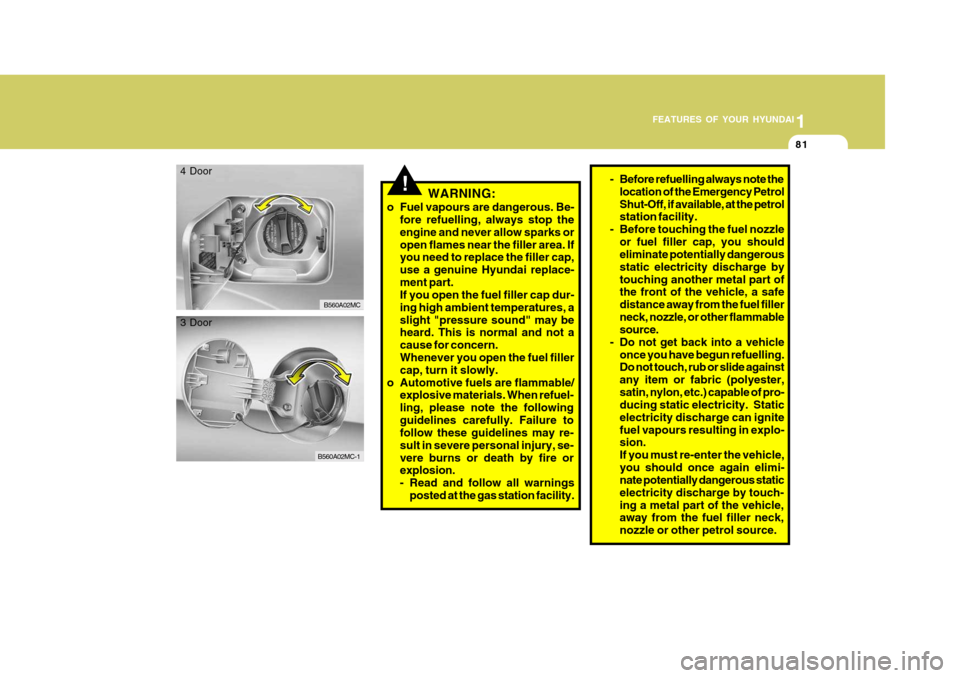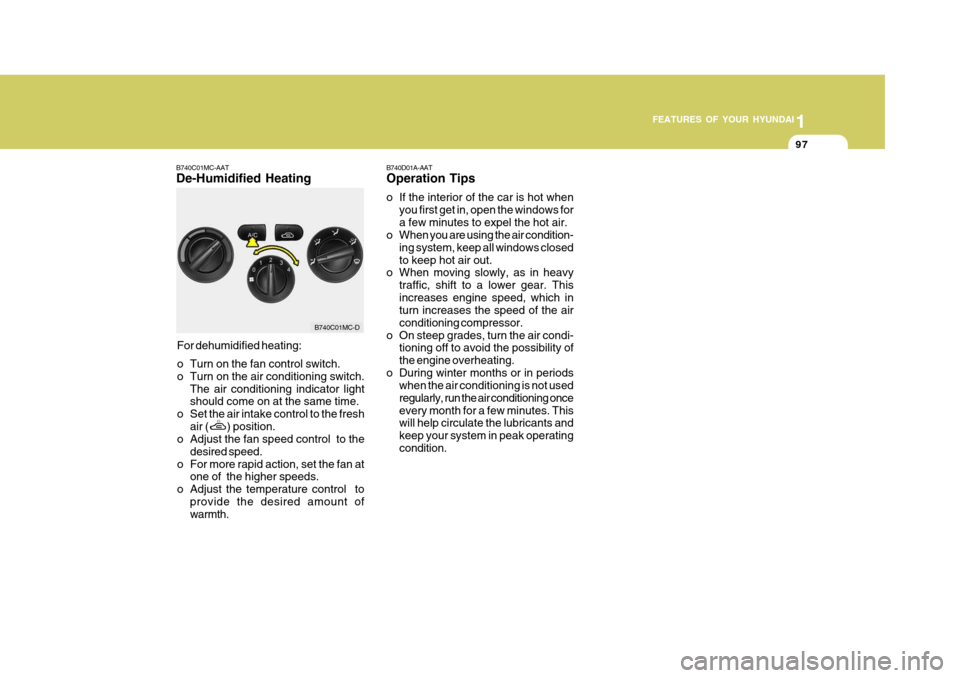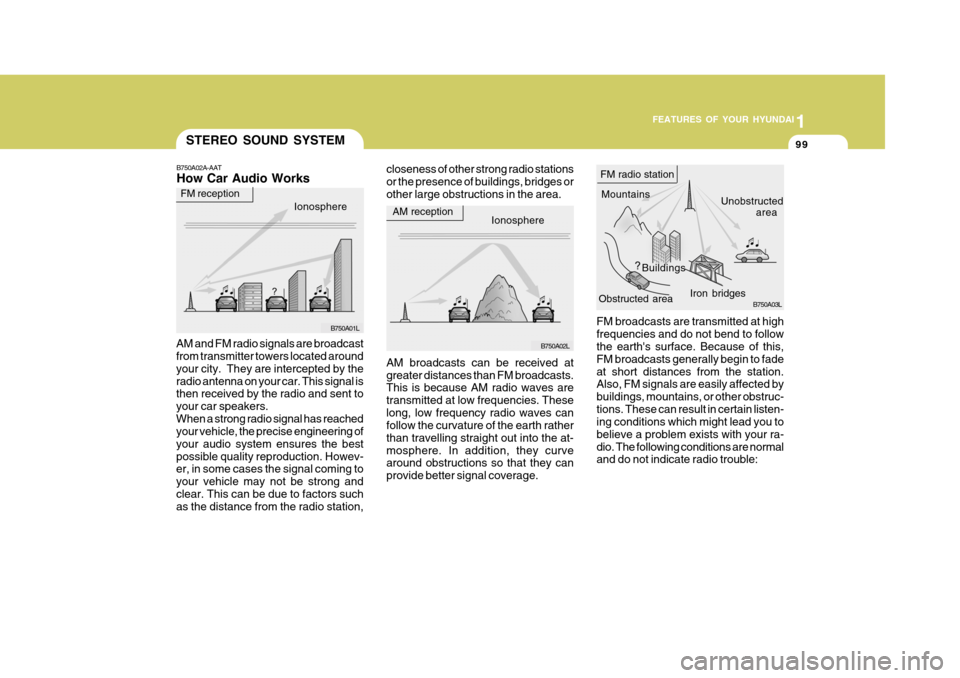Page 67 of 232
1FEATURES OF YOUR HYUNDAI
56
OMC029512L
The tachometer registers the speed of your engine in revolutions per minute (rpm).
B330A02A-AAT TACHOMETER
B300A01A-DATSPEEDOMETER Your Hyundai's speedometer is cali- brated in kilometers per hour.
!
CAUTION:
The engine should not be increased to such a speed that the needle en-ters the red zone on the tachometer face. This can cause severe engine damage and may void your warranty.
OMC029513
CAUTION:
Avoid driving with a very low fuel level. If you run out of fuel, it could cause the engine to misfire and re-sult in excessive loading of the cata- lytic converter.
!
Page 78 of 232
1
FEATURES OF YOUR HYUNDAI
67FOG LIGHT SWITCH
B360A01Y-DAT REAR FOG LIGHT SWITCH To turn on the rear fog lights, push the switch. They will come on when the headlight switch is in the second posi-tion and the key is in the "ON" position.
B360B01FC-GAT FRONT FOG LIGHT SWITCH (If Installed)
To turn on the front fog lights, push the switch in the "ON" position. They will come on when the headlight switch isin the first or second position.
CAUTION:
Do not clean the inner side of the rear window glass with an abrasive type of glass cleaner or use a scraperto remove foreign deposits from the inner surface of the glass as this may cause damage to thedemister elements. NOTE: The engine must be running for the rear window demister to operate.
!
B360B01MC-D
B360A01MC-D
Page 80 of 232
1
FEATURES OF YOUR HYUNDAI
69POWER OUTLET
B500D01TG-DAT
These supply 12V electric power to operate electric accessories or equip- ment only when the key is in the "ON"or "ACC" position. OMC029106R
!
CAUTION:
o Only use the power outlet when the engine is running. The use of this outlet with the engine notrunning may cause the battery to be discharged.
o Do not use the power outlet to
connect electric accessories orequipment other than those de- signed to operate on 12 volts.
o Some electronic devices can cause electronic interference whenplugged into the power outlet.These devices may cause exces- sive audio noise and malfunctions in other electronic systems or de-vices used in your vehicle.
ASHTRAY
To use the ashtray, open the cover. To remove the ashtray to empty or clean it, pull it all the way out.
B430A01MC-GAT
OMC025103R
Page 91 of 232

1FEATURES OF YOUR HYUNDAI
80REMOTE FUEL-FILLER LID RELEASE
B560A01MC-DAT The fuel filler lid may be opened from inside the vehicle by pulling up on the fuel filler lid opener located on the frontfloor area on the right side of the car. NOTE: If the fuel filler lid will not open because ice has formed around it, tap lightly or push on the lid tobreak the ice and release the lid. Do not pry on the lid. If necessary, spray around the lid with an ap-proved de-icer fluid (do not use radiator anti-freeze), or move the vehicle to a warm place and allowthe ice to melt.
OMC025017R
Before closing the bonnet, return the support rod to its clip to prevent it fromrattling. Lower the bonnet until it is about 30 cm (1 ft.) above the closed position and let it drop. Make sure thatit locks into place.
!
CAUTION:
Make sure that the support rod has been released prior to closing the bonnet.
!WARNING:
o Always double check to be sure that the bonnet is firmly latched before driving away. If it is not latched, the bonnet could fly open while the vehicle is being driven,causing a total loss of visibility, which might result in an acci- dent.
o The support rod must be inserted completely into the hole providedin the bonnet whenever you in-spect the engine compartment. This will prevent the bonnet from falling and possibly injuring you.
o Do not move the vehicle with the bonnet in the raised position, asvision is obstructed and the bon-net could fall or be damaged.
Page 92 of 232

1
FEATURES OF YOUR HYUNDAI
81
!WARNING:
o Fuel vapours are dangerous. Be- fore refuelling, always stop the engine and never allow sparks oropen flames near the filler area. If you need to replace the filler cap, use a genuine Hyundai replace-ment part. If you open the fuel filler cap dur- ing high ambient temperatures, aslight "pressure sound" may be heard. This is normal and not a cause for concern. Whenever you open the fuel filler cap, turn it slowly.
o Automotive fuels are flammable/ explosive materials. When refuel-ling, please note the followingguidelines carefully. Failure to follow these guidelines may re- sult in severe personal injury, se-vere burns or death by fire or explosion.
- Read and follow all warnings
posted at the gas station facility.
B560A02MC
4 Door
B560A02MC-1
3 Door
- Before refuelling always note the
location of the Emergency Petrol Shut-Off, if available, at the petrol station facility.
- Before touching the fuel nozzle or fuel filler cap, you shouldeliminate potentially dangerous static electricity discharge bytouching another metal part of the front of the vehicle, a safe distance away from the fuel fillerneck, nozzle, or other flammable source.
- Do not get back into a vehicle
once you have begun refuelling.Do not touch, rub or slide against any item or fabric (polyester,satin, nylon, etc.) capable of pro- ducing static electricity. Static electricity discharge can ignitefuel vapours resulting in explo- sion. If you must re-enter the vehicle,you should once again elimi- nate potentially dangerous static electricity discharge by touch-ing a metal part of the vehicle, away from the fuel filler neck, nozzle or other petrol source.
Page 93 of 232

1FEATURES OF YOUR HYUNDAI
82
!
BOOT LID / TAIL GATE
B540A01MC-DAT
WARNING:
The boot lid or tail gate should always be kept completely closedwhile the vehicle is in motion. If it is left open or ajar, poisonous ex- haust gases may enter the car re-sulting in serious injury or death to the occupants. See additional warn- ings concerning exhaust gases onpage 2-2.
- When using a portable fuel con- tainer be sure to place the con- tainer on the ground prior to refuelling. Static electricity dis- charge from the container canignite fuel vapours causing a fire. Once refuelling has begun, contact with the vehicle shouldbe maintained until the filling is complete. Use only portable fuel containers designed to carry andstore petrol.
- Do not use mobile phones
around a petrol station or whilerefuelling any vehicle. Electric current and/or electronic inter- ference from mobile phones canpotentially ignite fuel vapours causing a fire. If you must use your mobile phone use it in aplace away from the petrol sta- tion.- When refuelling always shut theengine off. Sparks produced by electrical components related tothe engine can ignite fuel vapours causing a fire. Always insure that the engine is OFF before andduring refuelling. Once refuel- ling is complete, check to make sure the fuel filler cap and doorare securely closed, before start- ing the engine.
- Do not light any fire around a petrol station. DO NOT usematches or a lighter and DO NOT SMOKE or leave a lit ciga-rette in your vehicle while at a petrol station especially during refuelling. Automotive fuel ishighly flammable and can, when ignited, result in explosion by flames.
- If a fire breaks out during refuel- ling, leave the vicinity of thevehicle, and immediately con-tact the manager of the petrol station or contact the police and local fire department. Followany safety instructions they pro- vide.
Page 108 of 232

1
FEATURES OF YOUR HYUNDAI
97
B740D01A-AAT Operation Tips
o If the interior of the car is hot when you first get in, open the windows for a few minutes to expel the hot air.
o When you are using the air condition-
ing system, keep all windows closedto keep hot air out.
o When moving slowly, as in heavy
traffic, shift to a lower gear. Thisincreases engine speed, which in turn increases the speed of the air conditioning compressor.
o On steep grades, turn the air condi- tioning off to avoid the possibility ofthe engine overheating.
o During winter months or in periods when the air conditioning is not usedregularly, run the air conditioning onceevery month for a few minutes. This will help circulate the lubricants and keep your system in peak operatingcondition.
B740C01MC-AAT De-Humidified Heating
For dehumidified heating:
o Turn on the fan control switch.
o Turn on the air conditioning switch. The air conditioning indicator light should come on at the same time.
o Set the air intake control to the fresh air (
) position.
o Adjust the fan speed control to the
desired speed.
o For more rapid action, set the fan at one of the higher speeds.
o Adjust the temperature control to provide the desired amount of warmth.
B740C01MC-D
Page 110 of 232

1
FEATURES OF YOUR HYUNDAI
99
B750A01L
STEREO SOUND SYSTEM
Ionosphere
AM reception
Mountains
Buildings Unobstructed
area
FM radio station
B750A03L
Ionosphere
FM receptionObstructed area
Iron bridges
FM broadcasts are transmitted at high frequencies and do not bend to follow the earth's surface. Because of this, FM broadcasts generally begin to fadeat short distances from the station. Also, FM signals are easily affected by buildings, mountains, or other obstruc-tions. These can result in certain listen- ing conditions which might lead you to believe a problem exists with your ra-dio. The following conditions are normal and do not indicate radio trouble:
AM broadcasts can be received at greater distances than FM broadcasts. This is because AM radio waves are transmitted at low frequencies. Theselong, low frequency radio waves can follow the curvature of the earth rather than travelling straight out into the at-mosphere. In addition, they curve around obstructions so that they can provide better signal coverage.
B750A02A-AAT How Car Audio Works
AM and FM radio signals are broadcast from transmitter towers located around your city. They are intercepted by theradio antenna on your car. This signal is then received by the radio and sent to your car speakers.When a strong radio signal has reached your vehicle, the precise engineering of your audio system ensures the bestpossible quality reproduction. Howev- er, in some cases the signal coming to your vehicle may not be strong andclear. This can be due to factors such as the distance from the radio station,
B750A02L
closeness of other strong radio stations or the presence of buildings, bridges orother large obstructions in the area.